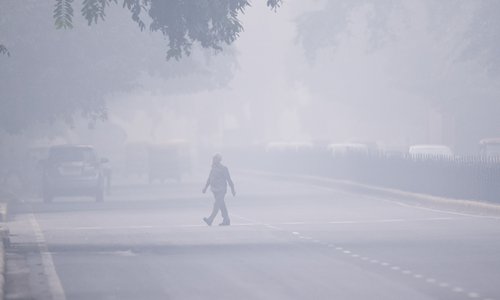HOME >> CHINA
Study shows China not to blame for regional smog
By Xu Keyue and Sun Haoran Source:Global Times Published: 2019/11/20 23:58:40
India ‘may learn’ Chinese methods

A man crosses a street in smoggy conditions in New Delhi, India on Monday. Millions of people in India's capital started the week choking through "eye-burning" smog, with schools closed, cars taken off the road and construction halted. Photo: AFP
The study released by South Korea's National Institute of Environmental Research on Wednesday may end the long-lasting blame game that South Korea plays, and more importantly, it can help Northeast Asian countries identify the real causes of pollution and work together to combat it, experts told the Global Times on Wednesday.
Conducted by experts from China, South Korea and Japan, the study found that an average of 51.2 percent of ultrafine dust in South Korea comes from domestic factors. At the same time, China and Japan contributed 91 percent and 55.4 percent to their own pollution.
"This finding strongly refutes their [South Korea's] incorrect reports. It can help the three countries clearly understand the source of pollutants and reduce mutual grievances, which makes it easier for them to reach a consensus on cooperation on environmental protection," Wang Gengchen, a research fellow at the Atmospheric Physics Institute of Chinese Academy of Sciences, told the Global Times on Wednesday.
"It is unreasonable for Japan and South Korea to blame China for causing the ultrafine dust in their own countries just because of China's rapid development and the serious pollution in some areas of the country," Wang said.
"Now the truth has come to light that the haze in South Korea is mainly 'Made in South Korea,'" read a popular comment on China's twitter-like Weibo.
Joint efforts in Northeast Asia
To combat the regional haze headache, China has actively worked with South Korea and Japan. The three countries have carried out cooperation for many years on trans-boundary pollution control.
According to the report of the 20th Tripartite Environment Ministers Meeting (TEMM) among China, Japan and South Korea held in Suzhou, Jiangsu Province in 2018, the three countries have convened sessions of the Tripartite Policy Dialogue on Air Pollution (TPDAP) and promoted cooperation in a range of areas, including policies and technologies for air pollution prevention and control, the prevention and control of PM2.5 (micro-particulate matter), Volatile Organic Compounds (VOCs), ozone and other pollutants from road and non-road sources, and air quality monitoring and assessment.
To further promote cooperation in air pollution control, working groups, which are devoted to scientific research on prevention and control as well as technology and policy on air quality monitoring and prediction, have held regular joint seminars for mutual exchanges and cooperation, read the report.
"Smog transcends national boundaries. It has become a regional problem which requires cooperation rather than blaming each other," Zhang Yuanxun, a professor of resources and environment at the Chinese Academy of Social Sciences, told the Global Times on Wednesday.
China and South Korea pledged to exchange artificial rain technologies and conduct joint research on the origins of air pollutants and on reducing fine particulate pollution in Northeast Asia. China is known as one of the world's leaders in the field of artificial rain, along with the US.
Zhang pointed out that the causes of air pollution in South Korea are similar to those in China, which usually include industrial and auto vehicle emissions. "Local emissions play an important part in South Korea's pollution, which South Korean scientists have admitted in some academic circumstances," he said.
China's lesson for India
Reuters reported in September that Chinese capital Beijing is on track to drop out from the list of the world's top 200 most-polluted cities this year, with hazardous smog concentrations falling to their lowest on record in August, data compiled by IQAir AirVisual showed.
In comparison, CNN reported in March that 22 of the top 30 most-polluted cities in the world are in India, citing a new report by the Greenpeace and AirVisual in March. India has seven of the world's 10 cities with the worst air pollution, but previously smogbound Chinese cities have seen a marked improvement, the report said.
As air pollution shot up to dangerous levels across India, underscoring an already dire public health crisis, wealthy Delhi residents turned to oxygen bars as toxic smog engulfed the city.
Oxygen bars saw business boom as they offered fresh air of all flavors, charging 500 rupees ($7) every 15 minutes. "Pay to breathe the air… Poor Indian friends," a Chinese netizen commented on social media which was "liked" by many others.
A report on Sunday by Indian media outlet the Hindu Business Line said that India could emulate China's policy interventions and technology to counter the pollution crisis, including energy infrastructure optimization, coal-fired pollution control and emission controls.
The report also noted that Beijing is a good example of how a large city in a developing country can balance environmental protection and economic growth as the city has achieved impressive air quality improvements in a short amount of time.
RELATED ARTICLES:
Posted in: SOCIETY